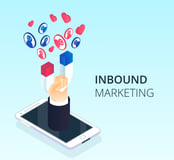Index Content
If you have an ecommerce or you want to make your business known within the networks, you must get down to work and carry out a digital marketing strategy. Giving blindly to the tun tun will not lead you to anything, having a structured strategy is key to success. Still do not know what steps you should follow to start your strategy? Do not worry, in this post we tell you step by step how to carry it out!
what is digital marketing?
Let's start by clarifying the concept of digital marketing, which encompasses all advertising actions or strategies that are executed on the Internet, in its media and channels. This has been applied since the 90s, based on bringing all offline marketing techniques to the Internet world. This has had to adapt to the changes of digital technology, so in a very short time and constantly has undergone many changes.
Advantages of digital marketing
If you are still not sure whether or not to get started in the world of digital marketing, or if it will bring benefits to your business, read on! Here we bring you a series of advantages that you should take into account when deciding whether or not to embark on a digital marketing strategy.
- All results are measurable
Within a digital marketing campaign everything can be measured, from the impact that the campaign has had to the ROI obtained. Moreover, not only is there this advantage, but this data can be obtained instantly, you can know whether or not your strategy is bearing fruit in real time. Which is an advantage over traditional marketing with which not only are there certain things that cannot be measured, but those that are measurable, can not be obtained so easily.
But, if there is so much data that we can obtain, what exactly are we referring to?
- A very clear example of this and very valuable to obtain is the positioning of the keywords used within Google.
- Information related to users such as the number of visits to your page and the behaviour of users within it, such as how long they have stayed on the page, whether they have interacted..
- Also included is all the information related to the blog, especially in terms of its content and positioning, where we include the number of visits it gets, how users behave within it, etc.
- On the other hand, we have the performance of the online advertising campaigns we have launched, as well as the CTAs we have placed in places like the blog.
- Last but not least, we have the conversions, a key element in obtaining information since what we most want as a company is to convert users into leads and leads into customers.
- Segmentation
Digital marketing campaigns are much more precise than traditional marketing campaigns, as internet users leave a large amount of information that we can use to our advantage and segment them according to a series of factors and characteristics such as age, gender, tastes... This not only helps us to create our buyer persona perfectly, but also helps us to create actions that are aimed at exactly who we want to reach. With all the data you have, you will know what to target and at what exact moment to get them to convert. - Constant gain
One of the biggest benefits of creating a digital marketing strategy is that after investing in it, what you will achieve is that your brand will increasingly have a reputation and authority on the internet, unlike traditional marketing where you invest to promote your brand within a specific period of time.
Steps to create a digital marketing strategy
Now let's move on to explain how to create a digital marketing strategy from scratch, and we will do it step by step.
- Set measurable goals
The normal thing to do when creating an online business is to set goals from the beginning, which are common to many start-ups, these are the most common ones:
- Generate brand awareness: If you are an emerging brand, it is normal that you want to make yourself known and make your products and services better known to as many people as possible.
- Acquisition of leads: It is not enough to reach a large number of users, the real goal is that these users end up becoming leads, which we can lead to the end of the sales process.
- Loyalty: A purchasing process never ends with the sale, our objective once we have already acquired a customer must be to build customer loyalty, that is to say, that they feel so satisfied with their purchase that they want to repeat.
All these objectives should be set taking into account the metrics within a given period of time. If you want to get leads, you have to set as a goal how many leads and how long it will take to know if your strategy is working or not.
- Know your audience
The next step is key, you have to define very well your buyer persona so you know which audience you have to conquer and thus direct your strategy directly to it, so you also classify your users from most to least important and you can define different strategies. This is usually done by defining your customers in three or four well-defined groups. - Define your proposition
Your brand is what determines whether or not users will choose you to cover their needs, so you have to stand out from your competition, project with your image the help you can provide to your consumers. - Analyse your competition
First of all, you should know that there are two types of competitors:
- Direct competitors : These are those who offer the same as you, i.e. if you have a pizzeria, all pizzerias are your direct competitors.
- Indirect competitors : These do not offer the same products but compete either in the same space or in the same budget, which means that, based on the example of the pizzeria, any other fast food restaurant would be your competitor.
For this we have to analyse our competition in depth, only then will we be able to differentiate ourselves from them, seeing what their website is like, what customer profile they have and so on.
- Measure results
It is essential in any digital marketing strategy to measure the results, especially to be able to monitor your strategy and see if the objectives set at the beginning have been met. In a digital marketing strategy there are a large number of KPIs that measure whether during X period of time objectives have been met. Therefore, a KPI must be specific, measurable, achievable, realistic and temporary.
In short, the steps you must follow to create a digital marketing strategy start by defining your objectives, getting to know your audience and creating your buyer persona, then defining your value proposition to users and customers, analysing the competition and finally measuring the results obtained after the objectives set in the first step.

-1.webp?width=200&name=imagotipo_occam%20(1)-1.webp)



